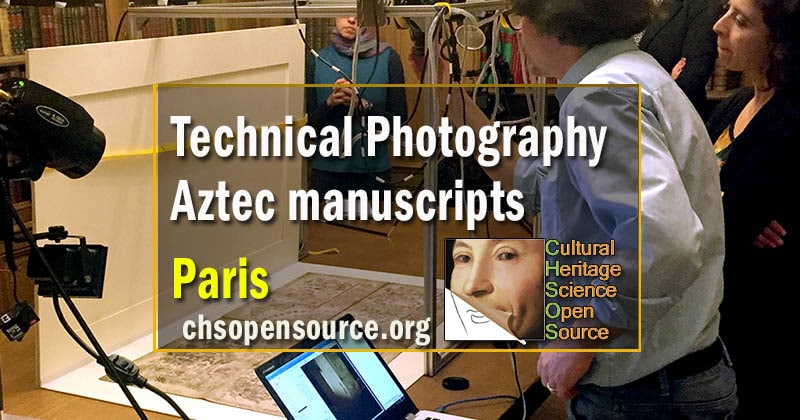
We just performed (March 20 and 21) Technical Photography documentation of other Aztec manuscripts at the Bibliothèque Nationale de France. These documents have European writing in the Aztec language, Nahuatl, on them that is no longer legible. They also have corrections to non-alphabetic indigenous writing with the potential to become legible through Technical Photography.
Dr Jerry Offner is Associate Curator of Northern Mesoamerica at the Houston Museum of Natural Science and he heads a group of scholars from France, Spain, Poland and Germany that has been studying the documents and holding meetings for nearly five years. Some members of the group have been studying the documents for more than four decades.
CHSOS has been involved in this research since 2016. Click and read more on our previous examination in Paris in 2016.
Among these manuscripts we worked again on the Codex Xolotl, the best example we have of Aztec historiography—their distinctive rules and methods for writing history. It portrays events from the 13th through the 15th century, ending nearly a century before Spanish contact. Its different pages or leaves were considered so important by the Aztecs that they were copied over and over across the contact boundary of 1519-1521 and assembled into what we call the Codex Xolotl by about 1540.
The goal of this study was to produce a technical photography documentation of the manuscripts in the ultraviolet and infrared spectral range in order to:
- increase reading of faded inks and paints
- identify pigments and inks
- identify support paper
- differentiate inks
- evaluate and understand the transfer and non-transfer of images between the two larger fragments of the Codex Xolotl and the reverse of its first leaf.
LEARN MORE. Read the blog post from the Houston Museum of Natural Science
CLICK HERE for more info
This study aimed at evaluating how these technical photography methods could enhance the reading of faded inks and paints on these very distinctive and indigenous kinds of manuscripts. They are indeed very different from European manuscripts whose supports and drawing and painting material are well known and studied. These Mesoamerican manuscripts were crafted using mostly supports and pigments available locally so it was not clear what information these imaging diagnostics techniques would be able to provide.
I would like to thank the Bibliothèque Nationale de France for allowing this examination and especially Laurent Héricher, Chef du service des manuscrits orientaux, Département des Manuscrits for facilitating this project.
Equipment
These images were acquired using our Technical Photography Kit. Four examination methods were used:
VIS. Standard visible light photography.
IR. Infrared photography (in raking light)
UVF. Ultraviolet photography
UVR. Reflected Ultraviolet.
In order to acquire high resolution images of the folios we used Archimedes, our multipurpose scanner for Art Diagnostics. It is a modular low-cost, mobile and lightweight scanner that can accommodate a number of diagnostic imaging methods such as Technical photography, Infrared Reflectography, Multispectral Imaging, and X-Radiography. Archimedes is one Scanner for all imaging methods. It has been developed specifically for Paper conservators since this scanner is particularly useful for library assets such as manuscripts, prints, and drawings that need to be kept flat. The imaging cameras can be scanned over the paper objects which can safely rest on the table. Archimedes can fits even a large infrared reflectography camera and it helps to safely acquire high-resolution imaging of the items.
Technical Examination for Paper Conservation
DOWNLOAD Technical Examination for Paper Conservation (6300 downloads )


















